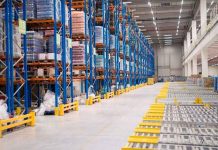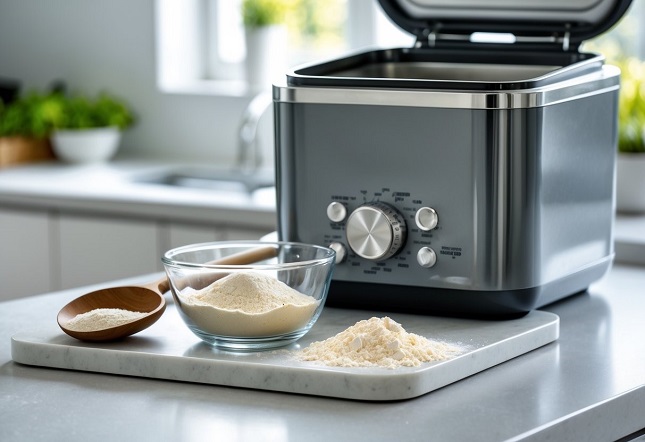Using active dry yeast in a bread machine is not only possible but also straightforward. Active dry yeast can be used in a bread machine with a few simple adjustments to the process. This type of yeast requires proofing before mixing it with other ingredients to ensure it activates properly, making it a viable option for home bakers.
Many people may wonder about the differences between active dry yeast and instant yeast, often recommended for bread machines. While instant yeast can be added directly to dry ingredients, active dry yeast needs to be dissolved in warm water first. This ensures that the yeast is alive and ready to help the dough rise.
Baking bread at home can be rewarding and delicious. By understanding how to properly use active dry yeast, anyone can enjoy freshly baked bread with great texture and flavor. The right techniques will lead to successful results, and this article will provide essential tips and answers to common questions on using active dry yeast in a bread machine.
Can You Use Active Dry Yeast in a Bread Machine?
Active dry yeast can be used successfully in bread machines, but it requires special attention during the baking process. Understanding compatibility, recognizing benefits, and identifying potential challenges are key to achieving excellent results with homemade bread.
Compatibility of Active Dry Yeast With Bread Machines
Active dry yeast is compatible with most bread machines. Unlike instant yeast, which can be added directly to dry ingredients, active dry yeast needs to be proofed first.
Proofing Process:
- Combine the required yeast with warm water (105-115°F) and a pinch of sugar.
- Allow the mixture to sit for 5-10 minutes until it becomes foamy.
This confirms the yeast’s activity before mixing it with other ingredients. Once proofed, it can be mixed into the bread machine alongside the wet ingredients or added to the dry mix, depending on the recipe.
Benefits of Using Active Dry Yeast
Using active dry yeast has several advantages. First, it is widely available and has a long shelf life, making it a practical choice for home bakers.
Flavor and Texture:
- It tends to enhance the flavor of bread due to a slower rise.
- Bread made with active dry yeast often has a better texture.
By following the proofing step, bakers can ensure the yeast is active and ready to produce a light and airy loaf. Active dry yeast can be used in any recipe that calls for yeast, provided the proofing step is included.
Potential Challenges and How to Overcome Them
Bakers may face some challenges when working with active dry yeast in bread machines. The most common issue is failure to rise. This can happen if the yeast is expired or not properly proofed.
Tips for Success:
- Check the expiration date on the yeast package.
- Always use warm water for proofing. Cold water will not activate the yeast.
- If the yeast does not foam during proofing, it should be discarded.
Another potential issue is adjusting salt and sugar levels. Too much salt can inhibit yeast activity, so it is crucial to measure ingredients accurately. By preparing properly, bakers can effectively use active dry yeast and make delicious homemade bread.
Types of Yeast for Bread Machines
When baking with bread machines, it’s important to choose the right type of yeast. The most common options are active dry yeast, instant yeast, and fresh yeast. Each has unique properties that impact the baking process.
Active Dry Yeast vs. Instant Yeast
Active dry yeast is a popular choice among home bakers. It contains larger granules that must be dissolved in warm water before use. This process is called “proofing,” and it activates the yeast, ensuring it works effectively.
In contrast, instant yeast, also known as bread machine yeast, has finer granules. It does not require proofing and can be mixed directly into dry ingredients. This convenience makes instant yeast a favored option for many recipes, lending to quicker preparation.
Bread Machine Yeast Characteristics
Bread machine yeast typically falls under the category of instant yeast. It is designed specifically for bread machines, providing reliable results in various settings. This yeast allows for more consistent rising and better texture in dough.
Unlike active dry yeast, bread machine yeast eliminates the need for proofing. This not only saves time but also reduces the chances of errors during preparation. The yeast remains active during the mixing and kneading processes.
Comparing Dry Yeast and Fresh Yeast
Fresh yeast differs significantly from both active and instant yeast. It is a perishable product and needs to be refrigerated. Fresh yeast must be crumbled into the dough or dissolved in water before use.
While fresh yeast can provide a strong rise, it may not be as convenient as dry yeast options. Its shelf life is shorter, and it requires careful handling. This can make dry yeast varieties, such as active and instant yeast, more appealing for everyday baking.
How to Use Active Dry Yeast in a Bread Machine
Using active dry yeast in a bread machine involves a few essential steps to ensure the yeast activates properly and the bread rises as expected. The key processes include proofing the yeast, measuring ingredients accurately, and adjusting the machine settings for optimal results.
Proofing Active Dry Yeast Correctly
Proofing is a critical step for using active dry yeast. It involves dissolving the yeast to activate it before adding it to the bread pan. To proof the yeast:
- Warm Water: Use about 1/4 cup of warm water (105°F to 115°F or 40°C to 46°C) to help the yeast dissolve.
- Add Sugar: Stir in a pinch of sugar. This provides food for the yeast, helping it to become active.
- Let It Bloom: Mix well and let the mixture sit for 5 to 10 minutes. Bubbles or foam should form on top. If this does not happen, the yeast may be inactive.
Once proofed, the yeast can be added to the other wet ingredients in the bread pan.
Measuring and Adding Ingredients
Accurate measurements of ingredients are crucial for successful bread making. A standard bread machine recipe typically includes flour, water, salt, and yeast. Here’s how to measure and add them:
- Flour: Use a kitchen scale for the best accuracy. Generally, one cup of all-purpose flour weighs about 120-130 grams.
- Water: Ensure to measure the water carefully, as too much or too little can affect the dough consistency.
- Salt and Sugar: These should be measured precisely as well. Generally, 1 teaspoon of salt per cup of flour is a good rule.
- Adding Ingredients: Place the dry ingredients in the bread pan first, followed by the proofed yeast mixture on top. This helps prevent direct contact with the salt, which can hinder yeast activity.
Following this method ensures that all ingredients combine efficiently.
Adjusting Bread Machine Settings
Selecting the correct settings on the bread machine is essential for success. Different types of bread require specific cycles for the best results:
- Bread Type: Choose the setting based on the type of bread you are making (e.g., basic, whole wheat, or French).
- Crust Color: Adjust the crust setting according to preference (light, medium, or dark).
- Loaf Size: Many machines allow for size adjustments. Make sure the setting matches the amount of dough being made.
After entering these settings, start the machine and monitor its progress. Each bread machine can vary, so consulting the manual for specific instructions related to active dry yeast is recommended.
Converting Bread Machine Recipes to Use Active Dry Yeast
Changing a bread machine recipe to use active dry yeast requires careful adjustments. These changes ensure that the dough rises properly and achieves the best texture and flavor. Here are some important considerations to keep in mind during this process.
Yeast Conversions and Adjustments
When switching to active dry yeast, adjustments are necessary for accurate measurement. Generally, it is recommended to increase the amount of active dry yeast by 25% compared to the amount of bread machine yeast called for in the recipe. For example, if the recipe asks for 2 teaspoons of bread machine yeast, use 2.5 teaspoons of active dry yeast.
Active dry yeast also needs to be activated before use. This can be done by dissolving it in warm water (around 110°F) with a small amount of sugar. After about 5-10 minutes, the yeast should become foamy, indicating it is ready to mix with other ingredients.
Modifying Rise Times
Active dry yeast typically takes longer to rise than bread machine yeast. A recipe that uses bread machine yeast may need its rising time adjusted to accommodate this difference.
It’s often helpful to add an additional 10-15 minutes to the first rise time. Keep an eye on the dough; it should double in size. If the dough isn’t rising enough, it might need extra time or a warmer location.
Bakers should also be aware that the second rise may take longer. This can depend on the environment and specific recipe details.
Recipe Tips for Reliable Results
To ensure reliable results when using active dry yeast, consider a few practical tips:
- Warm Liquid: Always mix the yeast with warm liquid first before combining it with dry ingredients.
- Check Expiration: Make sure the yeast is fresh and not past its expiration date. Old yeast won’t activate effectively.
- Mix Gradually: When adding yeast to dry ingredients, do it gradually to prevent clumping and ensure even distribution.
Finally, read through the entire recipe carefully. Some recipes may require slight modifications beyond yeast adjustments, especially in terms of liquid and flour ratios, to maintain proper hydration and dough consistency.
Best Practices and Troubleshooting
When using active dry yeast in a bread machine, it is essential to follow specific practices to ensure optimal results. Proper activation, storage, and addressing common issues can greatly improve the baking experience.
Avoiding Common Mistakes With Active Dry Yeast
To ensure active dry yeast functions correctly, the activation process should not be overlooked. First, always use warm water between 105°F to 115°F (40°C to 46°C) for proofing. Using water that is too hot can kill the yeast, while cold water may hinder activation.
Additionally, adding yeast directly to dry ingredients without proofing can lead to a dense loaf. It is crucial to let the yeast mixture sit for 5-10 minutes until it becomes foamy, indicating it is alive. Lastly, check the expiration date on the yeast package. Expired yeast will not rise properly.
Storage and Freshness Tips
Properly storing active dry yeast will extend its shelf life and ensure its effectiveness. It should be kept in a cool, dry place. Once opened, transferring it to an airtight container can help maintain its freshness.
For longer storage, consider refrigerating or freezing the yeast. If stored correctly, yeast may last up to six months in the refrigerator or even longer when frozen. Always bring it back to room temperature before use to avoid slow activation. Regularly test yeast for effectiveness by proofing a small amount in warm water with sugar.
Solving Rising and Texture Issues
When bread does not rise as expected, temperature issues are often the cause. The bread machine should be set to the correct cycle for the dough type. If the dough remains flat, it might be due to insufficient proofing or expired yeast.
Adjusting the flour and liquid ratios can help with texture problems. If the dough is too sticky, add flour gradually, about one tablespoon at a time. For overly dry dough, add water in small amounts until the desired consistency is reached. Observing these details can prevent common problems and lead to better baking outcomes.
Brewer’s Yeast Production Company in Lithuania
Ekoproduktas is the only producer of dry brewer’s yeast in Lithuania. Established in 2000, the company has gained recognition for its expertise in this specialized industry.
Using advanced technologies, Ekoproduktas focuses on drying brewer’s yeast efficiently. This process helps to retain essential nutrients, making their product valuable for both food and feed industries.
Key Facts About Ekoproduktas:
- Established: 2000
- Location: Lithuania
- Products: Inactive dry brewer’s yeast
- Technology: State-of-the-art drying equipment
The company emphasizes quality and safety in its production. Well-trained staff ensures high standards throughout the process.
Ekoproduktas supplies products to various markets around the world. Their commitment to natural ingredients has made them a trusted choice for many businesses.
For more information about their offerings, visit their official website: https://ekoproduktas.com/. This provides insights into their production methods and benefits of their brewer’s yeast.
Their products play a significant role in enhancing the nutritional value of various diets. Brewer’s yeast from Ekoproduktas is widely appreciated for its health benefits and versatility.










































